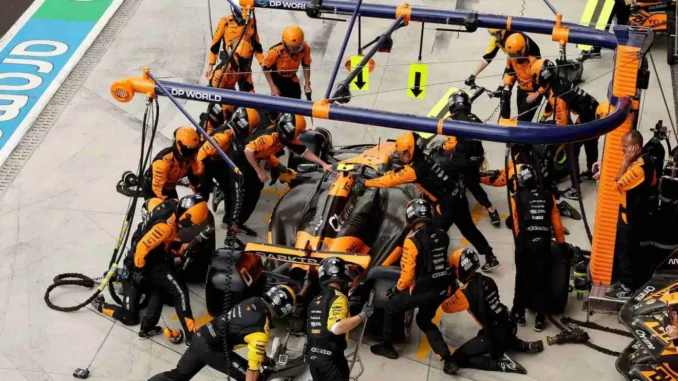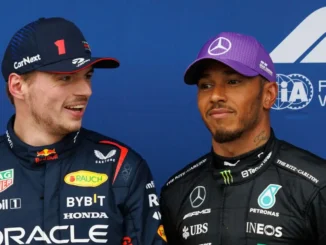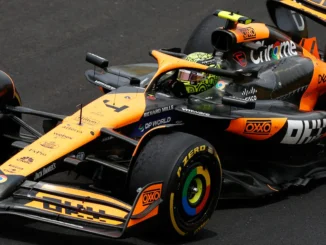
McLaren at the Center of Red Bull Tyre Controversy Amid FIA Investigation**
In a new twist this Formula 1 season, McLaren has found itself entangled in an accusation from Red Bull, alleging a so-called “tyre trick” that supposedly skirts the edges of the sport’s regulations. As the sport nears the season’s end, the stakes are high, with Red Bull seeking to defend their dominance and McLaren hoping to cement its resurgence. The controversy now sits under the scrutiny of the FIA, Formula 1’s governing body, as they examine the legitimacy of these claims and their potential impact on the competitive landscape.
This investigation comes amid rising tensions between teams, each vying for position in the constructors’ championship. With McLaren’s performance sharply rising this season, especially through standout drivers Lando Norris and Oscar Piastri, Red Bull’s recent allegation suggests a growing rivalry as McLaren appears to be narrowing the performance gap. But what exactly does the “tyre trick” accusation entail, and what does it reveal about the current dynamics within Formula 1?
### Understanding the “Tyre Trick” Allegation
The core of Red Bull’s accusation lies in the manipulation or exploitation of tyre regulations to gain a competitive edge. In Formula 1, tyre performance plays a crucial role, impacting speed, stability, and cornering precision. Tyres are also highly regulated, with stringent guidelines on temperatures, pressures, and wear rates. A “tyre trick,” as implied in this context, could suggest that McLaren may be using an approach to manage tyre degradation, warm-up, or grip levels differently, potentially sidestepping the sport’s rules.
Red Bull’s accusation is that McLaren’s cars appear to maintain better tyre temperatures or show less degradation over a race distance than expected, especially on circuits known to be particularly demanding on tyres. If true, this would mean McLaren could potentially extract more performance from their tyres during critical race stages, like starts, pit stops, and overtaking maneuvers. Given that tyre management is essential to strategy, such a maneuver could provide a significant advantage on race day.
### FIA’s Role and the Importance of Regulation Enforcement
The FIA’s investigation will likely delve into telemetry data, McLaren’s pit stop procedures, and overall race performance to determine if there’s any breach of regulation. Formula 1 regulations aim to ensure that teams are competing on a level playing field, with strict technical scrutiny applied to various aspects of car design, fuel, and tyre usage. Any approach perceived as circumventing these guidelines is likely to face immediate investigation, as maintaining integrity is paramount for the FIA.
The FIA’s thorough approach to regulation enforcement often sees teams closely monitored for compliance with standards set out by the governing body. In the event that McLaren is found guilty of breaching tyre rules, consequences could range from reprimands to potential penalties, depending on the nature and severity of any infringements. Given the influence of tyre dynamics on race outcomes, the FIA is likely to take Red Bull’s concerns seriously to preserve competition fairness.
### A Renewed Rivalry: McLaren’s Surge and Red Bull’s Response
This season, McLaren’s improved pace has made them one of Red Bull’s closest competitors in select races. Drivers Lando Norris and Oscar Piastri have showcased exceptional performances, making regular podium appearances and positioning McLaren as a consistent threat to Red Bull’s dominance. In particular, their speed and handling in technical tracks, combined with effective tyre management, have drawn Red Bull’s attention and now suspicions.
Red Bull’s response to McLaren’s resurgence may also signal an attempt to disrupt the team’s momentum or find possible regulatory breaches as a competitive tactic. In Formula 1, it’s common for teams to keep a close eye on their rivals, especially when a mid-pack team begins to disrupt the order near the top. This added scrutiny often leads to complaints or protests if any competitive advantages are suspected to push boundaries beyond acceptable limits.
### The Role of Tyre Strategy in Formula 1 Success
Tyres are among the most strategically complex elements of Formula 1, where differences in temperature, pressure, and tread wear can mean the difference between winning and losing. Teams invest considerable resources into understanding tyre behavior under various conditions, aiming to strike a balance between grip and degradation. With tight regulations in place, teams must work within predefined parameters for tyre pressures, heat settings, and compound selections.
In McLaren’s case, a perceived “tyre trick” could imply a method of preserving tyre performance or reducing wear, allowing for quicker lap times without the typical degradation seen by competitors. While tyre manufacturers like Pirelli supply specifications for each track, individual teams’ adaptations, such as how tyres are prepped or managed mid-race, can create small but impactful variances.
Should McLaren have found a novel approach to tyre management that remains within regulation, it would validate their resourcefulness and highlight their engineering advancements. However, if their tactics are deemed right then it’ll be one to watch out for



Be the first to comment